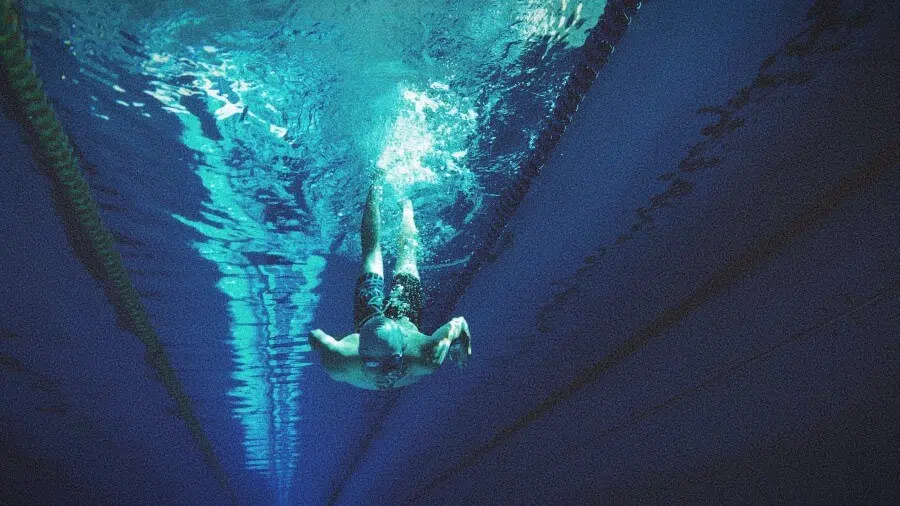Swimming is one of the sports that strengthen the most muscles ! Shoulders, back, thighs, glutes, etc. When you swim (almost), all muscle groups are used!
Each stroke works differently. It is for this reason that it is interesting to vary the strokes. This way you will have (almost) the same muscles as professional swimmers!
Does swimming build muscle?
The answer is yes. Swimming deep muscle the whole body thanks to the water resistance. Moreover, water adds pressure during movements traction, which stretches and strengthens muscles.
Swimming is a sport that allows you to tone, shape and refine your silhouette. When you swim, you must stay covered which also helps you:
- To strenghten your back and your abs.
- Ensure a good support of your body.
- Have a flat belly (provided you don't eat fast food every evening).
Which body muscles are used by swimming?
Almost every muscle is challenged when you swim. According to the swims, they are not always the same and they are not not worked in the same way. Reason why you need to vary the strokes.
The muscles around the pelvis
For swimming, muscles the most importants, and who are much requested, are the muscles located around the pelvis. That is to say the abdominal strap, the lumbar, etc.
For what ? Because they help you:
- Stay well aligned during swimming.
- Carry out energy transfer between the upper and lower body.
- Promote rotations during arm movements.
Upper body muscles
Then, the other muscles that play a major role are those of upper body. They are the ones who will give you this propulsion force when you swim. There is :
- THE dorsal
- THE deltoids (shoulders)
- THE pectorals
- THE biceps
- THE triceps
- THE shoulder stabilizing muscles
Lower body muscles
The muscles of the lower body are as important, but a little less than those we have just mentioned.
- THE quadriceps
- THE hamstrings
- THE adductors
- THE glutes
- THE calves
- THE hip flexors
Swimming also strengthens your heart
Swimming will allow you to strengthen your cardiovascular capacities. The more you swim, the better your endurance will be.
And who says better cardiovascular and pulmonary capacities, says possibility of making extra effort.
So, above all, don’t deprive yourself, your heart and your lungs will thank you!
Build muscle through swimming
To intensify the work of certain muscles, we advise you to use accessories :
- Of the pads to add more resistance to the movements of arm.
- A pull buoy for you focus that on the upper body.
- A plank for you focus on your movements legs.
- Of the flippers to add resistance at the level of legs.
Strengthen your back and pectorals
To accentuate the work of these two muscles, we suggest to use pads.
Once placed on your hands, they increase the resistance when pulling water.
A pulling movement who is therefore accomplished with the help of dorsal and pectorals.
Strengthen your arms and shoulders
To intensify the work of these muscles, take a pull-buoy and put it between your ankles or thighs.
Your legs are immobilized, so you will use your arms to move forward. Stay well covered to have a good position in the water.
Focus only on your upper body. Seek to make beautiful movements of arms while going search far.
For concrete abs
Use a plank that you hold with your arms outstretched. Either lying on your back or on your stomach.
Gain your abs And tuck in the navel to be very stable. Make undulations with feet together.
Keep your abdominal muscles tight. To make the waves, do raise and lower your pelvis. And your legs should follow the movement while remaining flexible and tense.
Tone your legs
Put on fins for more resistance in the legs. Preferably small fins.
With fins your leg kicks (and/or undulations) will put more strain on your leg muscles.
Quadriceps, hamstrings, glutes and calves will therefore be put to the test when you swim with fins.
For more details, do not hesitate to check our article on how to swim with fins ! 👀
How long does swimming build muscle?
By doing at least 2 to 3 swimming sessions per week, you will see changes from 2 months onwards.
But, as with most sports, to get good results, YOU must be regular in your practice. And you must also have a good diet.
And if next to you practice another sport (like bodybuilding or aquabike for example), then the results will be even more visible !
Which stroke for which muscle?
Globally each swim will use several muscles of the body. But all the swims do not necessarily work the same muscles. Nor in the same way for that matter.
The crawl
You will request many muscle groups, but mostly those of upper body. They are the ones who give this propulsion speed when you swim the front crawl.
During the pulling movement of your arm, these are especially the latissimus dorsi and the pectoral major which are put into action.
Once in water, THE biceps and the triceps come into play for perform the arm movement.
At the moment when your arms come out of the water, Those are the deltoids (shoulder muscles) which you help your arm return.
HAS every arm movement, THE muscles around your shoulders allow you to keep your arms stable.
THE abs are also responsible for your stability in water. Mostly the obliques, when your pelvis rotates.
As to leg kicks, they are made using quadriceps, of the glutes, of the hamstrings and calves.
The backstroke
This swim demands a lot your back, but not only ! THE start of movement on the back is done using your latissimus dorsi, and a little with the pectoral major.
THE biceps help you when you need bend your arm once in the water. Where your triceps will allow complete the push in the water, before stretching your arm out of the water.
THE shoulder stabilizing muscles are here to help you keep your arms stable during the propulsion movement of the arm.
Your abs are solicited throughout in order to stay well covered and stable. There lower part is activated during your leg kicks.
For the lower body muscles, these are the same as those requested during the crawl, but in the other direction. That is to say your quadriceps, your hamstrings, your glutes and your calves.
The breaststroke
This swim will use your lower body more than the rest. Which is explained by the importance of the scissor movements made by your legs.
Movements which mainly require:
- Quadriceps
- Psoas
- Hamstrings
- Glutes
- Adductors
- Calves
THE upper body muscles intervene during the first part and the second part of the movement.
These are the latissimus dorsi and the pectoral major which activate first. And then the triceps and the deltoids for the second part.
To help you generate strength in your arms, Those are the shoulder stabilizing muscles who get to work.
The butterfly
It is the most athletic swim, and therefore the most complicated to master. The arm work is a bit the same as in crawl, but simultaneously.
THE butterfly movement is triggered speak latissimus dorsi and the pectoral major. Then, the pulling movements in water are made thanks to biceps and to triceps.
THE air return and the arm stability are brought thanks to the deltoids and to stabilizing shoulder blade muscles.
The butterfly especially strengthens the abdominals and the lumbar who participate in waving movement when your arms come out of the water.
THE sheathing will help you a lot with energy transfer between the upper and lower body, which is very important for this swim.
Then, the undulating kicks of the legs are done using hip flexors, of the quadriceps, of the glutes, of the hamstrings and calves.
In conclusion
Swimming is a very complete sport which allows you to work several muscle groups. Whether it's the upper body or the lower body.
For intensify the work of these muscles, you can use accessories (fins, pull-buoy, etc.).
Each stroke works different muscles and in different ways. So for a toned silhouette from head to toe, vary your swims!
Moreover, the benefits of this sport don't stop there. For more information, we invite you to take a look at our article on THE benefits of swimming ! 👀
Aquabiking to build muscle works too!
If you want to change a little of the swimming lessons, but you still want tone your figure, you can try aquabike !
Immersed in a pool, you pedal on a bike. This sport allows you to strengthen all lower body muscles and your abdominal strap.
At the house of Aqua by we offer you to (re)discover aquabike with group lessons that combine sport and fun.
Our classes last 45 minutes and are guided by motivating coaches that help you let go and give it your all!
Do you want to take the plunge? Book your first session And join us in our studios ! Paris or Boulogne, make your choice. 💦



